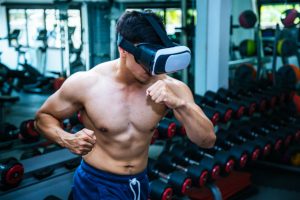There is no doubt a new fitness phenomenon on account of Virtual Reality and it is letting us exercise in our world, thus powering through tsunamis and also becoming the superheroes one has always wanted to be.
Playing tennis is simply not enough. It is indeed not a satisfying workout to simply swing one’s arm forward and backward dressed in pyjamas in one’s living room, knowing full well that one will be back on the couch diving into some biryani.
Enter Virtual Reality to take one’s gaming and thus taking one’s workout to a whole new level.
Importance to space
One of the top players in this fitness subculture is Black Box VR, the first Virtual Reality gym, which is located in San Francisco.
The programs that are implemented in the Black Box VR game were created by top trainers and exercise scientists. Based on over 100 exercise studies, one’s body will indeed see immediate improvements that match or beat traditional exercise programs. One can push harder and work out more consistently, even if it does feel like a fun sport.
So how does it work? One needs to forget standing in an airy, brightly-lit gym with other people sweating it out — at Black Box VR, much like its name, one ends up standing in a dark space. But one is not just wearing the headgear that one would wear for a video game. While in a private room, one’s body is strapped with ergonomic sensors and controllers, so one’s focus is on the task at hand, working out using the equipment around oneself.
So what’s the actual experience like? Virtually placed in visceral environments, one needs to fight one’s way through a tsunami and exercise those glutes, calves as well as hamstrings, brave tough blizzards with dead-lift equipment working one’s pectorals, back and biceps, conquer the earth and fiery environments thus making use of one’s chest and shoulder muscles… one can embody Bear Grylls without going anywhere near a mound of dirt.
Black Box VR does claim Virtual Reality fitness that can be tailored to any scale of fitness level, whether one is just taking up that New Year’s resolution or one has the stamina of a gladiator.

Feedback is everything
A VR-equipped group who are exposed to a given environment, including a visual representation of an arm as well as the weight, do carry out the same lift and hold as the non-VR group.
The study does show a clear reduction in the perception of pain as well as effort when making use of VR tech.
The Artificial Intelligence in the system does make one learn one’s workout pattern and, with real-time resistance, ups the ante for one to adjust the machines and the simulations accordingly. Plus, the AI, which is rather easy to use by even the tech-illiterate, will indeed inform one to form needs to shift.
For the Indian market
Google ‘Virtual Reality fitness India,’ and one will not get satisfying results. Some gyms state they are a VR fitness zone, but actually only simply have a widescreen television set up opposite a treadmill. Virtual Reality workouts have not really made a home in India, but some have plenty of hope.
It is worth noting that space does require being VR-ready, totally separate from a mainstream gym; no sound or light interference which may interrupt the flow of a session. Ultimately, Virtual Reality, tapping into some already fitness-fanatic societies in the country, still do require some patience.
No doubt while VR itself seems to be an effective tool in pain management, it is worth noting the considerable amount of time required to maintain and clean the equipment — something which does need expert technicians.
Even in the UK, where the age of boutique gyms is reaching peak saturation, VR fitness is indeed yet to make itself known. Many factors have to be considered such as health and safety. a trainer, I love to go to the gym, smell the iron, work up a sweat and see the workouts around me.

